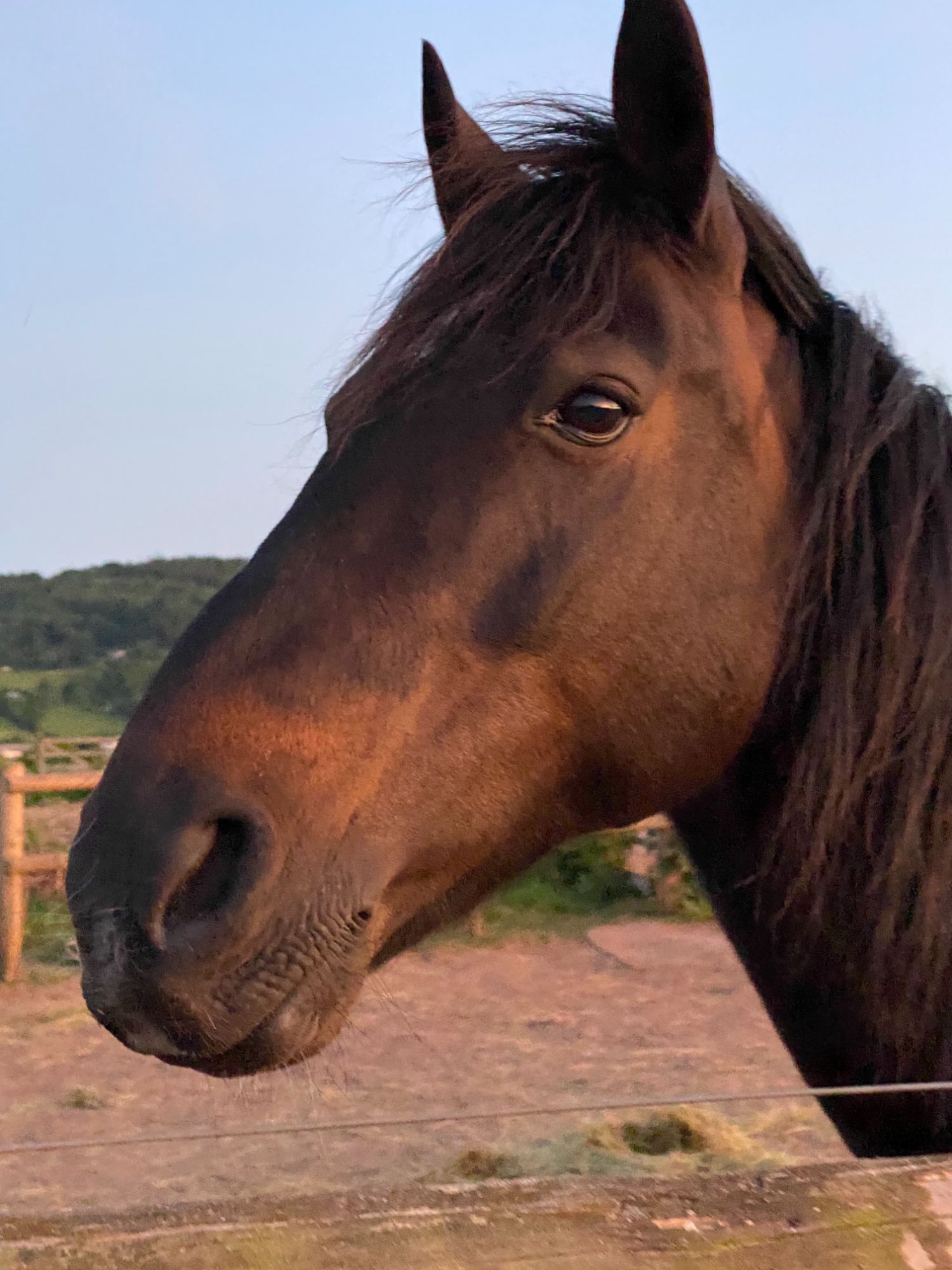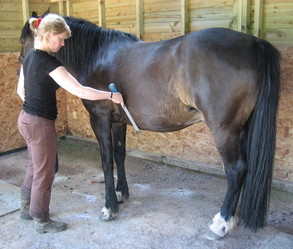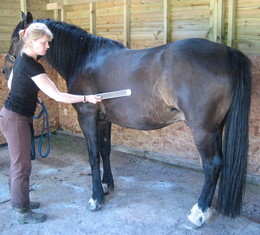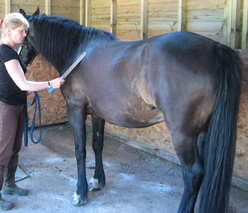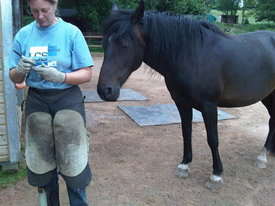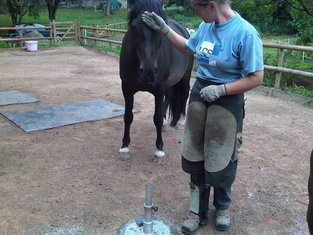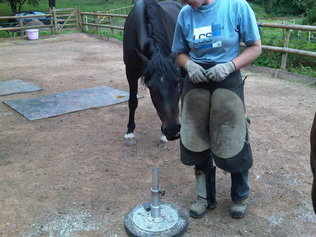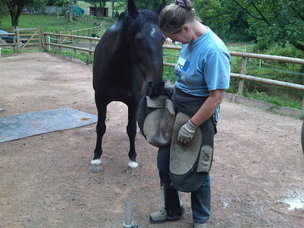Duke Overcoming his fear of the farrier
My first meeting with Duke.
I first met Duke cowering at the back of a herd of 5 horses. His owner had been unable to cope with him and so had put him out on loan after he had displayed some aggressive outbursts towards her in the field and had begun rearing whilst out hacking. Within 3 months Duke was back home. His owner had gone to see how he was getting on at his new loan home and had been horrified to witness that Duke was being made to go over a succession of jumps; rearing virtually to 90 degrees upon landing, then being whipped and made to continue. The rider was also using spurs aggressively. His owner immediately decided to take him back home.
Duke who had previously been a good loader, had to be blindfolded to load and arrived home drenched in sweat. My first meeting with him was the following day.
I was told that he would be difficult to catch and even when using the most submissive and non agressive body language, along with as low an energy as I possibly could, it became apparent that there was no way that Duke was going to trust me enough to let me put a head collar on him. So, after several attempts, when he went to move away, I gently sent him away from me by looking him directly in the eye, which horses interpret as aggressive and placing my shoulders square to his, again interpreted by horses as an aggressive gesture.
My aim behind this decision was to show Duke that being with me was his best option and a safe place to be.
When Duke showed signs of not wanting to be with me by running off, then I basically used my body language in such a way as to continue to send him away. I chose to do this to show him that I could influence his movement and that if he wanted to be away from me then that was fine.
I had my work cut out though as the field was large!
Duke chose to run in large circles around me as I continued to send him away by looking in his eye and squaring my shoulders to his.
After using my body language to influence changing his flight direction several times, I then began to see him offering me some clear signs of communication.
Firstly his ear nearest to me, locked onto me, a sign which basically means that the horse is showing you respect.
This was followed by Duke trying to make the circle smaller and trying to come closer to me.
I continued to keep him travelling on the outside of the circle as I needed to finish `the conversation' with him so to speak.
There were still two more signs that I was looking for from him, in order for an environment of co-operation to be set up between us.
In response to me keeping him on the outside of the circle he then began to lower his head, `bobbing' it along the ground, a sign of respect towards me.
And then finally I saw Duke `licking and chewing' which is a sign of submission, or relaxation, and which is similar to the gesture a foal often uses, whereby it will snap its mouth open and shut to the elder members of the herd.
At this point I then was able to 'invite Duke in' towards me.
I made the `invitation in' as strongly as I possibly could in his language, so as to reinforce his choice.
This I did by lowering my eyes away from his and turning my shoulder submissively at a 45 degree angle.
With my energy low, I stopped moving and waited as Duke gently walked over towards me and reached his nose out to touch my shoulder. I
I very quietly and carefully turned, keeping my eyes away from his and reached my hand up very gently to stroke his forehead. This took trust for Duke as I was touching an area that he can't see.
This was the moment of what Monty Roberts calls JOIN UP (TM).
From here I proceeded to walk calmly but assertively forwards, with Duke following me at my shoulder.
I turned left, and Duke turned left.
I turned right, and Duke turned right.
Wherever I chose to walk Duke was there at my shoulder.
This is known as FOLLOW UP.
Duke seemed such a gentle, willing horse and wore a submissive look on his beautiful face, carried his head low and when I stopped walking and just stroked him he let out a big sigh.
From here I gently put on the headcollar, as this was what I had initially set out to do. Duke offered no resistance at all.
I then asked him to move his hind quarters over. This he did easily from the near side, but he had difficulty on the off side. Duke was also very sensitive and tentative to touch on his off side. He also appeared, although willing, to have difficulty moving backwards. He didn't look comfortable and was carrying his tail slightly to one side, which suggested perhaps a misalignment of some sort.
Physical Checks.
I decided that before any training sessions took place I wanted to get his back alignment checked out and also wanted to see what was happening muscle wise as he was incredibly tight in places. I needed to know that he was sound physically before asking anything of him.
The assessments that were made confirmed that he had several misalignments.
Duke flinched at a hand touching his wither area, which was probably due to a badly fitting saddle and he was also incredibly tight around his poll and atlas area and in his neck muscles; also several large muscle groups in his quarters were not working correctly.
So Duke embarked on a series of McTimoney and physiotherapy sessions in order to help him feel more comfortable, and began to receive daily massage to try and loosen him up.
Quite often after his McTimoney sessions he would go out calmly into the field, let out a big sigh and just lie down to sleep, which was amazing to see as he generally was very highly strung and tended to do everything very quickly.
Talking to his owner, she told me how he had apparently arrived in this country from Ireland with a set of shoes on and had to be sedated to have them removed!
In all the time that Duke had been with her, he had shown a huge fear of the farrier and could only be trimmed with sedation.
This for me was the obvious place to start.
I had to rebuild the trust in Duke enough for him to have his feet trimmed regularly without sedation. If his feet were not in balance then this was obviously going to have a knock on effect on his alignment and muscles within his whole body.
Once Duke was more comfortable and looser physically I worked with him each day until he would give me all of his feet nicely and l could pick them out successfully, but even though he was willing he always seemed really uncomfortable about giving me his right front foot.
I suggested that Lindsay Cotterell trim his feet, as not only had she looked after my horses' feet excellently but she had also done all the Intelligent Horsemanship courses and had a good knowledge of the horses language which I felt was crucial at this stage for Duke.
Duke's first meeting with Lindsay.
Duke was always quite cautious of people generally, but upon meeting Lindsay for the first time, although wary, he allowed her to approach him and even lift his feet.
However...
When Lindsay then put on her trimming apron/chaps and produced the trimming equipment, he fled, snorting, breathing rapidly and looked absolutely terrified.
The equipment and chaps were removed from his sight and I set about catching him.
I proceeded to do some gentle ground work exercises to calm him, and eventually Lindsay was able to approach him again.
From here Lindsay took over and continued to move him gently around so that he could feel safe knowing that she could move him and influence his direction of movement.
Eventually he gave her all his feet again, though showed some reluctance with his right fore.
Lindsay was however able to have a good look underneath. Duke's front feet were pigeon-toed and underneath she observed a significant medial twist in his right hoof capsule with increased lateral wear and compensatory imbalance. She also felt that he was in physical discomfort when this limb was elevated as this provoked a huge adrenaline rush and panic.
It was very evident to her from his hoof wear that he was experiencing physical discomfort above.
For Lindsay to be able to trim Duke and handle him safely, a combined approach of physiotherapy, McTimoney Chiropractic work along with lots of ground work to ensure safe handling was going to be necessary.
Alongside this, a training plan aimed at desensitising Duke to the rasp, chaps and noise of metal banging was clearly going to be needed.
This approach would ensure the removal of any physical pain and restore psychological balance and well being in Duke, enabling him a successful way forwards.
It was during one of his McTimoney chiropractic sessions that there was a sudden loud `pop' sound which occurred as work was being done on his right foreleg, followed by a big sigh from Duke.
Following this he found it much easier and became much more willing to lift this foot.
Foot handling training.
My work with Duke involved much `advance and retreat' work with the rasp.
Initially Duke showed absolute terror of the mere sight of the rasp, sweating, snorting and not allowing it anywhere near him, and displaying moments of sheer panic.
I worked with him using a Monty Roberts dually head collar and a 30 foot line so that I knew I could stay attached to him just incase he ran off, he then wouldn't learn that this worked!
I initially would hold the rasp out in front and ask him to follow it (as anything that moves away from the horse won't be interpreted as predatorial).
This I mixed with gently trying to move the rasp towards Duke until I could touch him lightly on his shoulder with it. Each time Duke went to move away, I stayed with him and when he stopped moving I took it away. He soon began to learn that what he perceived as dangerous or predatorial (the rasp) went away when he stood still. He learnt he could effectively control the rasp by stopping and if it went away from him then it was acting in a non predatory manner and was therefore not a threat.
From here, using this advance and retreat method, I was gradually able to touch his neck and shoulder, eventually working my way down his legs, each time keeping the rasp on him when he was moving and then taking it away when he stood still. Allowing the rasp into his 'vulnerable areas' of his body without it hurting was again confirming to him that it wasn't going to hurt him and was therefore OK.
Gradually I increased the length of time I kept the rasp on him and gradually Duke realised there was no pain and nothing to fear.
Occasional flashbacks would occur but we worked through these calmly and I always kept the sessions short.
By the fifth session I was able to run the rasp over the front of his hoofs.
He was not completely comfortable with this but accepted it, and showed no signs of sweating. He allowed me to touch him with it all over his back, sides, legs and belly and he produced only one snort at the end of the session as we were following the rasp away.
During session six he showed no signs of sweating or snorting and seemed comfortable being touched all over and down his legs, allowing me to pick up both front feet and lightly rasp!
This was a real major breakthrough.
Finally during session seven he gave me both front feet straight away.
I picked his feet out and then rasped very lightly over the front, not taking off material but just getting him used to the sound, feel and action that Lindsay would be doing.
Duke stood beautifully and showed none of the signs of anxiety that he had showed at the beginning of the week.
I was also applying a more firmer and assertive rasping action.
From here I continued to use a cotton apron to act as chaps and then progressed to tying my waterproof jacket around my front like an apron. My jacket had the advantage of being a bit noisy as well, which was good for him to get used to.
He was cautious to begin with but his reaction was far less than it had been to the rasp.
During this session I also used another horse who was excellent with his feet.
I would go to the other horse, lift his foot and do a rasping action, then approach Duke and lift his foot and do the rasping action and then go back to the other horse and repeat.
This not only gave him short breaks and released any pressure on him, but also helped him see the other horse calmly accepting the rasp.
Lindsay's visits would include trimming two horses who were excellent with their feet whilst Duke watched freely of his own accord so he could walk away if he wanted to.
Generally he showed quite a bit of intrigue.
Lindsay would then approach Duke without her chaps and ask for his feet and then gradually supported my work by lightly rasping without the chaps and then we gradually introduced the chaps.
Lindsay effectively using excellent body language

These photos are taken from Lindsay's second visit. Notice how Lindsay raises curiosity rather than fear by using her body effectively.
Duke reaches out to investigate the chaps
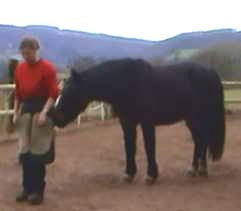
Notice how Duke responds to Lindsays submissive and non threatening body language. It allows him to reach out and investigate the chaps.
Carefully introducing the rasp
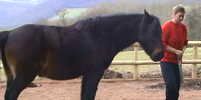
Lindsay keeps her body turned away and keeps the rasp very close to her body. She is careful not to use any eye contact.
Duke is nervous of Lindsay's touch with the rasp in her hand
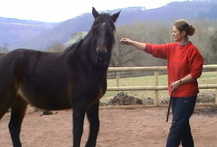
Duke tries to avoid Lindsay's touch when she has the rasp in her hand.
Duke protects his off side
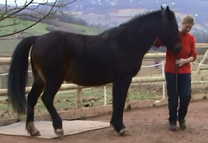
Lindsay tries very submissively to approach Duke's off side but he is very protective and tries to stop her going there. He initially moves away but Lindsay stays with him and eventually makes it there.
Lindsay manages to get to Duke's off side
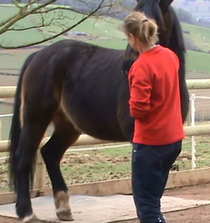
Once on Duke's off side Lindsay is very careful to keep the rasp very close to her body.
Working on aproaching Duke's off side
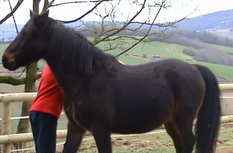
These steps although seemingly small are all huge for Duke, as he rebuilds his trust again, but I am pleased to say that Duke continues to go from strength to strength. He still sometimes has a tense moment, possibly a flashback from his past, but he is soon reassured and is generally fine now.
Trimming Duke's off Side
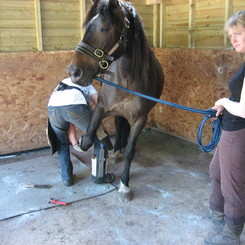
Duke's off side was his most sensitive side which he strongly protected.
Trimming with hoof stand
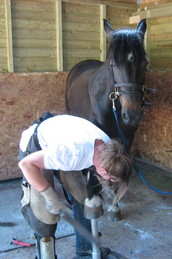
This was a huge leap of faith for Duke as he was very worried about the hoof stand initially.
Holding the off fore between the kinees for trimming
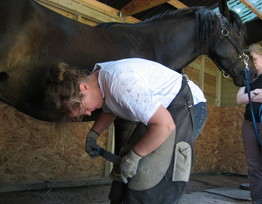
This had to be done gradually without closing the outer knee to start with and then gradually builiding up the time the foot was held up for.
exploring the hoof stand and letting Duke push it away
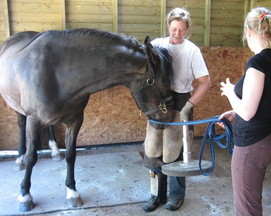
Anything that moves away from the horse they see as non predatory so allowing Duke to follow the hoof stand so that he was effectively pushing it away, helped Duke to see the hoof stand as non threating.
trimming near fore
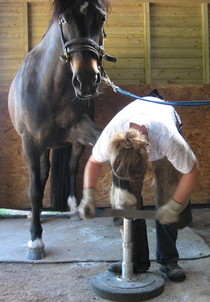
The near fore was alot easier for Duke.
The photos below show the various stage of training. After Duke was re introduced to the rasp and started to see it as something that wasn't going to hurt him, he then trusted me to gently place it in the vulnerable areas of his body, such as his neck, sides and underneath his belly. This was to show him it wasn't going to hurt him and that it was something he could trust. I was also able to access how his trust was growing.
I have included photos of Duke observing a more confident horse being trimmed in the early stages and how this helped to raise his curiosity enough for him to start wanting to explore the chaps. Note how Lindsay is being very mindful of her body language during this stage.
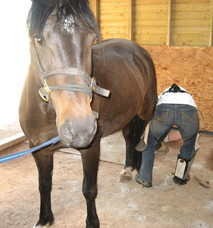
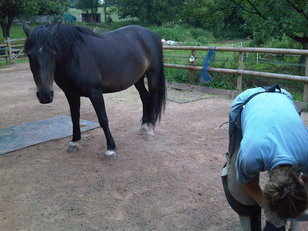
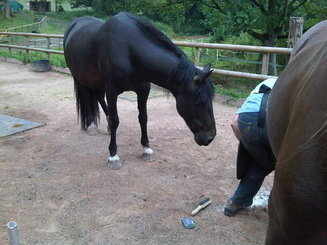
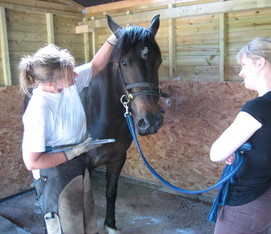
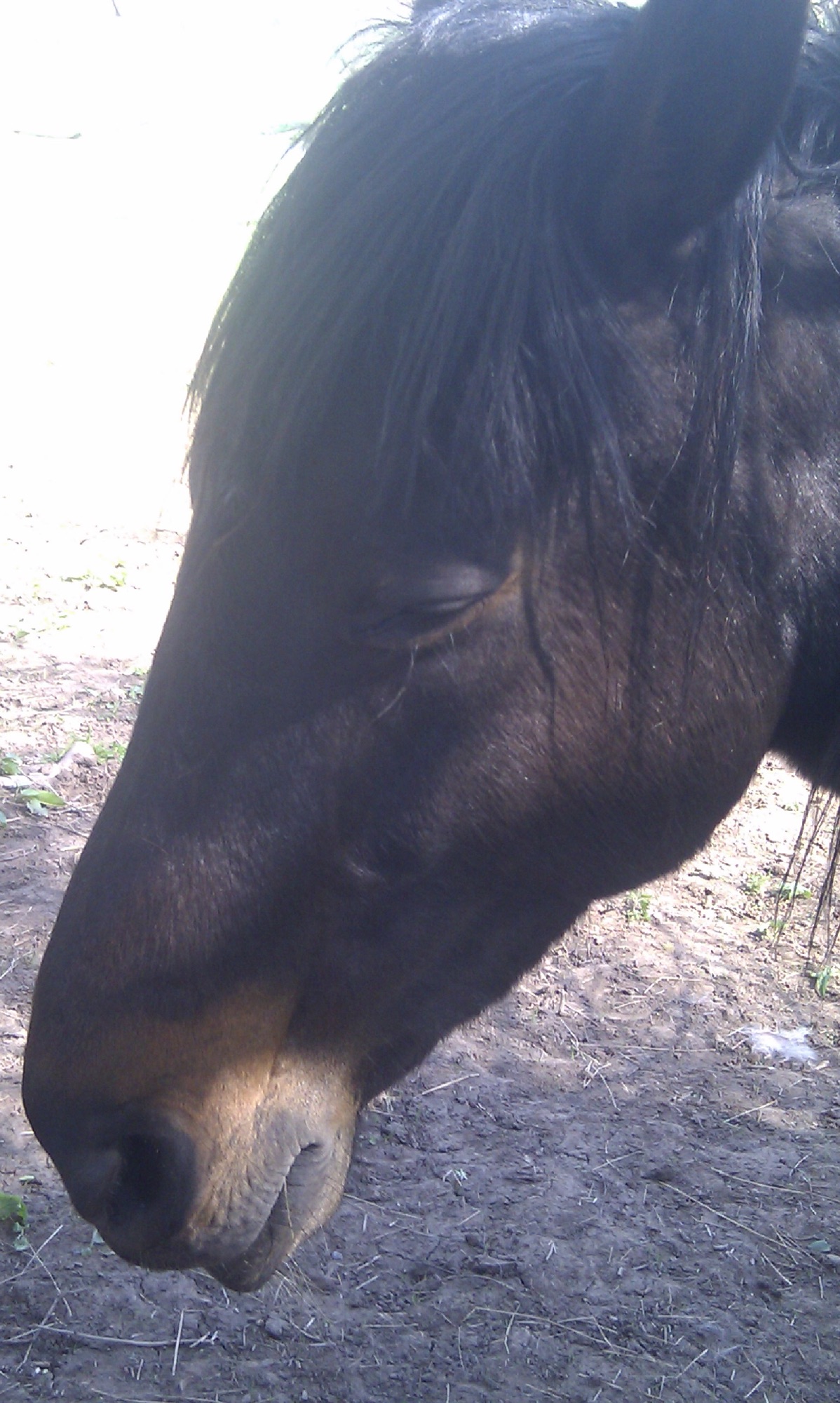
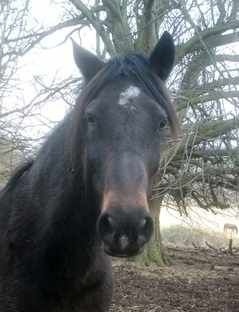
So now a days Duke allows Lindsay to trim all of his feet whilst remaining as relaxed as he can be throughout.
Over time Duke eventually came to fully accept the foot stand for his hinds too.
During his training with me he made quite a few friends and has ended up staying with me permanently. I decided not to re back him but to let him retire and live out his life as a companion in my small herd of horses. He enjoys being walked out in hand, massaged and loved dearly.
I have found Duke to be a great teacher, not just for me over the years that we have had together but often helping people to understand the importance of using their body language and energy in a way that isn't contradictory to what they want from him.
Lindsay commented after her first encounter with Duke that she had never witnessed any horse so terrified of the `farrier' image.
The method used to train Duke to overcome his fear was not difficult or complicated but based on the body language gestures that horses use with each other and the horses psychology.
So many problems can easily be fixed using this knowledge but just as importantly so many problems can easily avoided by using this knowledge.
I strongly believe that learning the language gestures of the horse and studying their psychology is surely the best gift you could ever give to your horse.
Duke's previous owner and I are hugely indebted to Lindsay for her tremendous patience and kind ways; helping Duke to rebuild this trust and find comfort again.
Also I would like to thank McTimoney Chiropracter Ruth Greenhill and Equine Physiotherapist Sarah Price for all their hard work and gentle ways with Duke, helping him on the road to recovery.
In my 13 years of helping horses I have yet to find a horse that was more terrified of the farrier than Duke. He has taught me so much and throughout the years we have developed an incredibly strong bond together. In turn I have been able to help many horses overcome their worries and bad foot handling experiences, which is truly so incredibly rewarding.
